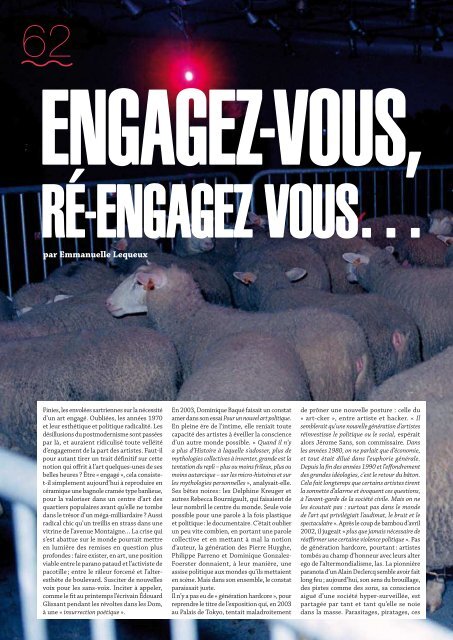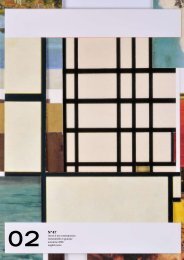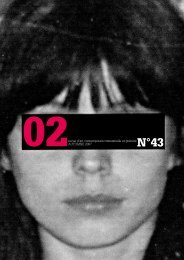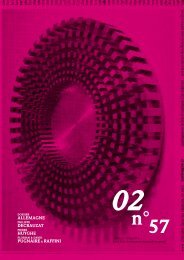par Céline Chazalviel
par Céline Chazalviel
par Céline Chazalviel
You also want an ePaper? Increase the reach of your titles
YUMPU automatically turns print PDFs into web optimized ePapers that Google loves.
62<br />
62<br />
<strong>par</strong> Emmanuelle Lequeux<br />
Finies, les envolées sartriennes sur la nécessité<br />
d’un art engagé. Oubliées, les années 1970<br />
et leur esthétique et politique radicalité. Les<br />
désillusions du postmodernisme sont passées<br />
<strong>par</strong> là, et auraient ridiculisé toute velléité<br />
d’engagement de la <strong>par</strong>t des artistes. Faut-il<br />
pour autant tirer un trait définitif sur cette<br />
notion qui offrit à l’art quelques-unes de ses<br />
belles heures ? Être « engagé », cela consistet-il<br />
simplement aujourd’hui à reproduire en<br />
céramique une bagnole cramée type banlieue,<br />
pour la valoriser dans un centre d’art des<br />
quartiers populaires avant qu’elle ne tombe<br />
dans le trésor d’un méga-milliardaire ? Aussi<br />
radical chic qu’un treillis en strass dans une<br />
vitrine de l’avenue Montaigne… La crise qui<br />
s’est abattue sur le monde pourrait mettre<br />
en lumière des remises en question plus<br />
profondes : faire exister, en art, une position<br />
viable entre le <strong>par</strong>ano pataud et l’activiste de<br />
pacotille ; entre le râleur forcené et l’alteresthète<br />
de boulevard. Susciter de nouvelles<br />
voix pour les sans-voix. Inciter à appeler,<br />
comme le fit au printemps l’écrivain Édouard<br />
Glissant pendant les révoltes dans les Dom,<br />
à une « insurrection poétique ».<br />
En 2003, Dominique Baqué faisait un constat<br />
amer dans son essai Pour un nouvel art politique.<br />
En pleine ère de l’intime, elle reniait toute<br />
capacité des artistes à éveiller la conscience<br />
d’un autre monde possible. « Quand il n’y<br />
a plus d’Histoire à laquelle s’adosser, plus de<br />
mythologies collectives à inventer, grande est la<br />
tentation du repli – plus ou moins frileux, plus ou<br />
moins autarcique – sur les micro-histoires et sur<br />
les mythologies personnelles », analysait-elle.<br />
Ses bêtes noires : les Delphine Kreuger et<br />
autres Rebecca Bournigault, qui faisaient de<br />
leur nombril le centre du monde. Seule voie<br />
possible pour une <strong>par</strong>ole à la fois plastique<br />
et politique : le documentaire. C’était oublier<br />
un peu vite combien, en portant une <strong>par</strong>ole<br />
collective et en mettant à mal la notion<br />
d’auteur, la génération des Pierre Huyghe,<br />
Philippe Parreno et Dominique Gonzalez-<br />
Foerster donnaient, à leur manière, une<br />
assise politique aux mondes qu’ils mettaient<br />
en scène. Mais dans son ensemble, le constat<br />
<strong>par</strong>aissait juste.<br />
Il n’y a pas eu de « génération hardcore », pour<br />
reprendre le titre de l’exposition qui, en 2003<br />
au Palais de Tokyo, tentait maladroitement<br />
de prôner une nouvelle posture : celle du<br />
« art-cker », entre artiste et hacker. « Il<br />
semblerait qu’une nouvelle génération d’artistes<br />
réinvestisse le politique ou le social, espérait<br />
alors Jérome Sans, son commissaire. Dans<br />
les années 1980, on ne <strong>par</strong>lait que d’économie,<br />
et tout était dilué dans l’euphorie générale.<br />
Depuis la fin des années 1990 et l’effondrement<br />
des grandes idéologies, c’est le retour du bâton.<br />
Cela fait longtemps que certains artistes tirent<br />
la sonnette d’alarme et évoquent ces questions,<br />
à l’avant-garde de la société civile. Mais on ne<br />
les écoutait pas : surtout pas dans le monde<br />
de l’art qui privilégiait l’audimat, le bruit et le<br />
spectaculaire ». Après le coup de bambou d’avril<br />
2002, il jugeait « plus que jamais nécessaire de<br />
réaffirmer une certaine violence politique ». Pas<br />
de génération hardcore, pourtant : artistes<br />
tombés au champ d’honneur avec leurs alter<br />
ego de l’altermondialisme, las. La pionnière<br />
<strong>par</strong>anoïa d’un Alain Declercq semble avoir fait<br />
long feu ; aujourd’hui, son sens du brouillage,<br />
des pistes comme des sons, sa conscience<br />
aiguë d’une société hyper-surveillée, est<br />
<strong>par</strong>tagée <strong>par</strong> tant et tant qu’elle se noie<br />
dans la masse. Parasitages, piratages, ces<br />
63<br />
crooners songs, buffet<br />
Claude Lévêque<br />
Strangers in the night 19 novembre 2000/ November 19 th 2000<br />
Performance. Soirée d’inauguration de l’exposition/Performance. Opening of the exhibition Au delà du<br />
spectacle, Centre Georges Pompidou, Paris<br />
3 enclos en barrières de sécurité, projecteurs, 67 moutons, DJ programmant une sélection de<br />
chanson de crooners, buffet/ 3 sheep pens made of guardrails, spotlights, 67 sheep, DJ selection of<br />
Conception sonore en collaboration avec/Sound design in co-operation with Frédéric Sourice<br />
Courtesy de l’artiste/ of the artist, Galerie kamel mennour, Paris<br />
Photo Jean-Claude Planchet<br />
© ADAGP Claude Lévêque<br />
Gone are the Sartrean tirades on the necessity<br />
of an engaged art. Forgotten, the<br />
1970s and their aesthetic and political<br />
radicalism. The disillusions of post-modernism<br />
have already been there, and are<br />
always ready to ridicule every weak stab at<br />
political engagement that issues from art<br />
world. Is it time that this notion, responsible<br />
for some of art’s beautiful moments,<br />
be definitively crossed off the list? Does<br />
being “engaged” today boil down to creating<br />
a ceramic reproduction of a burned car<br />
in the French banlieue, valorizing it in art<br />
space in an impoverished neighborhood,<br />
then watching as if falls into the hands<br />
of a multimillionaire? As radical-chic as<br />
army fatigues in lead glass in a shop window<br />
on the Avenue Montaigne... The crisis<br />
that has ravaged the world occasions some<br />
deeper soul-searching: to create, in art, a<br />
viable position between the heavy-handed<br />
<strong>par</strong>anoiac and the Saturday afternoon activist,<br />
between the ranter and raver and<br />
the dilettante alter-aesthete. To generate<br />
new voices for the voiceless. To raise<br />
the call for a “poetic insurrection,” as the<br />
by Emmanuelle Lequeux<br />
writer Edouard Glissant did in the Spring<br />
during the insurrections in the French<br />
Overseas De<strong>par</strong>tments.<br />
In 2003, Dominique Baqué came to a bitter<br />
realization in her essay Pour un nouvel art<br />
politique. In the era of intimacy in art, she<br />
renounced her belief that artists were still<br />
capable of raising consciousness of another<br />
world. “When there is no more History<br />
to lean back on, no more collective mythologies<br />
to invent, great is the temptation of<br />
a return--more or less cold-footed, more<br />
or less self-sufficient--to micro-histories<br />
and personal mythologies,” she argued.<br />
Her demons: the Delphine Kreugers and<br />
the Rebecca Bournigaults, who seemed to<br />
transform their own navel into the center<br />
of the world. The documentary becomes<br />
the only available avenue for a language<br />
both plastic and political. Perhaps this<br />
prognosis turned the page on the generation<br />
of Pierre Huyghe, Philippe Parreno<br />
and Dominique Gonzalez-Foerster a bit<br />
too quickly; these artists, who developed<br />
collective language and unsettled the no-<br />
tion of the author, built their worlds, after<br />
all, upon a political foundation. But, as a<br />
whole, the realization seemed to hold.<br />
There was never a “hardcore generation,”<br />
to revive the title of the 2003 exhibition at<br />
the Palais de Tokyo, which made a clumsy<br />
attempt at a new political stance: that of<br />
the “art-cker,” somewhere between an<br />
artist and a hacker. “It would seem that a<br />
new generation of artists is re-infiltrating<br />
the political and the social,” wrote a hopeful<br />
Jérome Sans, the show’s curator. “In<br />
the 1980s, all we talked about was the<br />
economy, and everything was diluted by<br />
the general euphoria. Since the end of the<br />
‘90s and the disintegration of the great<br />
ideologies, we are witnessing a case of history<br />
gone full circle. Certain artists have<br />
been sounding the alarm and raising these<br />
questions for a long time, from the avantguard<br />
to civil society. But we don’t listen<br />
to them, especially not in the art world,<br />
which privileges press ratings, noise, and<br />
sensationalism.” After the shock of the<br />
French presidential elections of 2002, he







